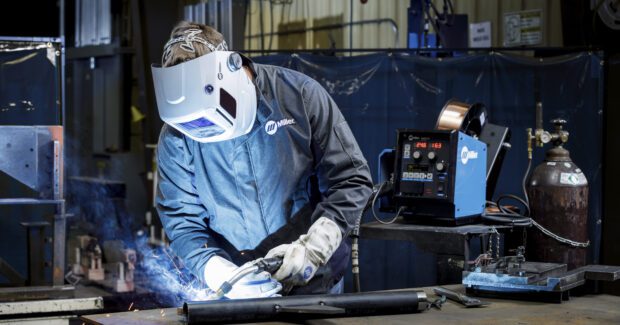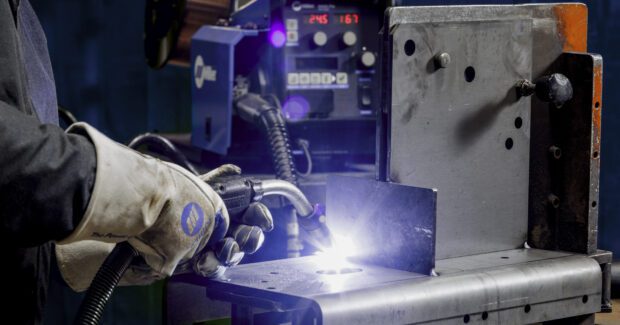Four Tips to Increase Arc-On Time
Consider the process as a whole from start to finish. Activities before and after welding, such as part fit-up and post-weld grinding, affect how much time welders actually spend under the hood.
Posted: January 29, 2020
WELDING TIPS
Average arc-on time in a semi-automatic welding operation is typically 10% to 12% — much lower than many manufacturers think. Finding ways to improve arc-on time can result in better throughput and cost savings. Paying attention to these four key factors can increase that percentage.
Is It the Right Welding Process?
Making a change to the welding process can result in significant benefits in the right applications. A switch from standard MIG to modified short-circuit MIG, for example, can help when an operation has big part gaps that can’t be fixed in fit-up because modified short-circuit MIG offers better gap-filling capabilities.
Pulsed MIG processes can help boost productivity through less spatter and faster travel speeds. Compared to standard MIG, a pulsed process can deliver 10% faster travel speeds using the same heat input.
The choice of filler metal and shielding gas can also affect arc-on time. While solid wire is commonly used for MIG applications, metal-cored and flux-cored wires might provide more benefits for productivity. It all depends on the welding process, the shielding gas, and the base material.
Many manufacturing operations use 100% carbon dioxide (CO2) shielding gas. However, a mixed gas such as 90% argon/10% CO2 produces much less spatter — so less time is spent on post-weld grinding — in addition to faster travel speeds.
Be aware that some of these changes may require reapproval of the Welding Procedure Specification (WPS) for operations that are working with one.
Part Fit-Up Is Important
When operations measure arc-on time, that figure doesn’t include the time spent on part fit-up or material prep. But these factors can significantly affect overall productivity and efficiency.
Large or uneven gaps between the parts being welded can slow the welder and increase spatter, resulting in more time spent on post-weld grinding.
The welder may or may not be the person responsible for part fit-up. In some operations, issues with poor part fit-up might trace back to the engineering or design phase. Taking the time to ensure consistent fit-up helps eliminate gaps and saves time in the long run.
Check the Consumables and Parameters
Troubleshooting problems like wire feeding issues reduces a welder’s arc-on time. If the gun liner or contact tip is too worn or the drive roll tension isn’t properly adjusted, it can contribute to wire feeding issues and result in increased spatter and poor weld quality. Worn weld cables or poor cable connections are also common causes of weld quality issues.
Properly maintaining the MIG gun and checking all consumable connections before each shift decreases the time spent troubleshooting.
It’s also important to make sure welding parameters are set correctly. This helps operators produce good welds and avoid time-consuming rework. Check for proper heat input, wire stick-out, and travel speeds, which are all factors that affect the occurrence of weld defects or issues that require rework or additional post-weld cleanup.
Producing a weld that requires rework can more than triple the amount of time spent in the process, greatly impacting efficiency and throughput.
Let Newer Technology Help
Power sources that are easier for welders of all skill levels to use help improve productivity and arc-on time. Some newer machines are designed with synergic control, simplified setup, and other technologies that can help operators save time and produce high-quality welds.
With synergic control, the power source automatically makes changes to correspond to any adjustments made by the operator. This helps ensure optimal parameters are used for the job.
Simplified setup is another way to help operators get welding faster. The operator inputs the thickness of the material being welded and the power source automatically sets the other parameters.
In addition, investing in data monitoring can allow manufacturers to track performance metrics and see what factors may be negatively affecting arc-on time and productivity. From basic systems to more advanced tracking and reporting, digital weld monitoring is available on a wide range of power sources.
Optimizing Arc-On Time
Many factors play a role in arc-on time, so don’t look just at the welding itself. Consider the process as a whole from start to finish. Activities performed before and after welding, such as part fit-up and post-weld grinding, significantly impact how much time welders actually spend under the hood.












